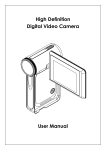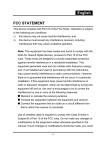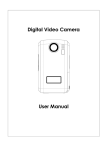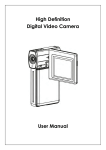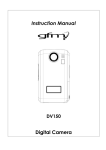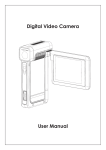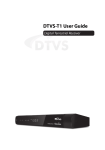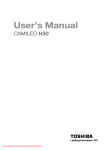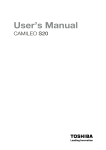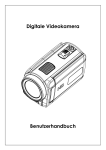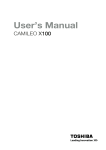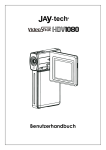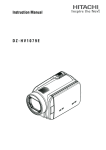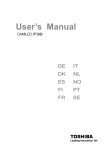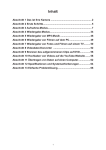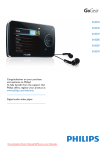Download User`s Manual
Transcript
User’s Manual User’s Manual Quick Start Guide Camileo CamileoHD HD CZ PL SK GR RU TR HU Introduction Welcome and thank you for choosing a TOSHIBA product. For your convenience, your TOSHIBA product is furnished with two guides: a)a Quick Start Guide, and b)a comprehensive PDF* User’s Manual on the included CD. * Requires Adobe Acrobat / Reader v. 5 or later. Free Reader Downloads at: www.adobe.com/products/acrobat/readstep2.html For details about your TOSHIBA product, refer to the User’s Manual or online documentation which contains further information. EN Contents Section 1 Getting to Know Your Camera........................................... 4 Overview.............................................................................. 4 Check the Components...................................................... 4 Safety Instructions.............................................................. 5 System requirements......................................................... 5 Front View............................................................................ 6 Rear View............................................................................. 6 Side View............................................................................. 7 Section 2 Getting Started.................................................................... 8 Loading the Battery............................................................ 8 Inserting and Removing an SD Card (Optional)............... 8 Protecting Data on an SD Card.......................................... 9 Turning the Camera On and Getting Started.................... 9 Turning the Camera Off...................................................... 9 Section 3 Record Mode..................................................................... 10 Button Function................................................................ 10 LCD Monitor Information.................................................. 11 H.264 Movie Recording.................................................... 12 Picture Recording............................................................. 12 Voice Recording................................................................ 13 Taking Close up Pictures................................................. 13 Using Digital Zoom........................................................... 13 Options for Record Menu................................................. 14 Operations for Record Mode........................................... 14 Default Setting and Validation......................................... 15 Movie Mode submenu Setting......................................... 16 Camera Mode Setting....................................................... 22 1 EN Contents Voice Mode........................................................................ 32 Effect Setting..................................................................... 32 Setting Menu...................................................................... 33 Section 4 Playback Mode.................................................................. 36 Button Function................................................................ 36 LCD Monitor Information.................................................. 37 Movie Playback................................................................. 38 Picture Playback............................................................... 42 Voice Playback.................................................................. 46 Section 5 Listening to MP3 Music.................................................... 48 MP3 Music......................................................................... 48 Transfer MP3 Music to the Camera................................. 48 Listen to MP3 Music......................................................... 49 Listen to MP3 Music with earphone................................ 50 Section 6 Viewing MP4 (MPEG4 AVC/H.264) Movie on PC....................51 View Movie on PC............................................................. 51 Share Movie....................................................................... 51 Section 7 Viewing Pictures and Movies on a TV............................. 52 Connecting to a high-definition TV................................. 52 Connecting to a non-high-definition 16:9 (Wide) or 4:3 TV....................................................................................... 53 Section 8 Video File Converter......................................................... 54 Section 9 Burning the Recorded Clip into DVD.............................. 58 2 EN Contents Section 10 Uploading Video Files to YouTube.................................. 60 Section 11 Transferring Data to a Computer..................................... 64 Installing the Digital Camera Driver................................ 64 Connecting Your Camera to a Computer........................ 64 Installing Bundled Software............................................. 65 Section 12 Specifications.................................................................... 66 Section 13 Troubleshooting................................................................ 67 Section 14 Other Information.............................................................. 68 TOSHIBA Support............................................................. 68 Operating Environment Conditions................................ 68 Regulatory information..................................................... 68 Additional information...................................................... 70 3 EN Section 1 Getting to Know Your Camera Overview The camcoder with 5 Mega Pixel sensor can take H.264 movies. By way of using H.264 technology, more videos can be taken within certain amount of memory. High quality images with up to 11 megapixels can also be delivered smoothly. With a color LCD monitor, users can compose images and examine them easily. The camcoder also features movie recording at HD resolution of 1280x720. You can also connect DV to a HDTV by HDMI cable, and easily playback recorded high-definition videos on the wide screen of an HDTV. Exposure and color balance can either be adjusted automatically or allowed to be changed manually. An 8x digital zoom increases user control over the movies and pictures you take. The camcoder is also ideally suited for using as a PC camcoder hooked up to your computer via high speed USB 2.0 port. Built-in memory allows you to take pictures and movies without memory card. The memory card slot allows users to increase the storage capacity. Note Partial memory of the built-in memory is used for Firmware code. Check the Components Unpack the package and make sure all standard accessories listed are included: Camcorder Quick Start Guide USB Cable CD-ROM (Software, User’s Manual) AV Cable HDMI Cable Earphone Strap 4 AC-Adapter Pouch Tripod Lithium-ion Rechargeable Battery Warranty leaflet EN Safety Instructions Avoid hearing damage Permanent hearing loss may occur if earphones are used at high volume. Set the volume to a safe level. You can adapt over time to a higher volume of sound that may sound normal but can be damaging to your hearing. If you experience ringing in your ears of muffled speech, stop listening and have your hearing checked. The louder the volume, the less time is required before your hearing could be affected. Hearing experts suggest that to protect your hearing: - limit the amount of time you use earphones at high volume - avoid turning up the volume to block out noisy surroundings - turn the volume down if you can’t hear people speaking near you System requirements • Mircosoft Windows 2000/XP/Vista • CPU Intel Pentium III 800MHz above • 256MB system memory • 4X CD ROM • 1GB free HDD space • 1 Available USB port • 16-bit Color Display Note The LCD screen is manufactured using extremely high-precision technology so over 99.99% of the pixels are operational for effective use. However, some tiny black and/or bright dots (white, red, blue or green) may appear on the LCD screen. These dots are a normal result of the manufacturing process, and do not affect the recording. 5 EN Front View Microphone Lens Flash Self-Timer LED LCD Panel Power Button Rear View Direction Button Enter Button Picture Shutter Button Movie Shutter Button Tele Button OK Button Wide Button RECORD/PLAY Button TV/Earphone Port Mini USB 2.0 port 6 EN Side View Macro Switch LCD Panel Speaker Battery / SD Card Cover 7 EN Section 2 Getting Started Loading the Battery Before using the Camera, end users must load NP 60 Battery. 1.Follow the arrow direction and slide to eject the battery cover. 2.Insert the batteries according to the correct polarity marks ( + or -). 3.Close the battery cover firmly. Eject Inserting and Removing an SD Card (Optional) The Camera comes with internal memory which allows you to store pictures, movies, voice recordings and music. You can expand the memory capacity by using an optional SD memory card. To insert a memory card, refer to the figure as below: 1.Insert the memory card into the right position. 2.To remove an installed SD card, press the card inwards to release it. 3.When the card pops out, gently remove it from its slot. Note When a memory card is fitted, movies and pictures are saved on card rather than on the built-in memory. 8 EN Protecting Data on an SD Card SD card is read-only by locking the SD card. No pictures, movies and voice can be recorded when the SD card is locked. Make sure the lock is on writeable position before recording any media. Writeable position Write-Protected Position Turning the Camera On and Getting Started To turn on the Camera: 1.Flip out the LCD panel; the Camera will turn on automatically. 2.Or press Power Button for one second to turn on it. • To take a movie, press the Movie Shutter Button ( • To take a picture, press the Picture Shutter Button ( ). ). ) to enter Record Menu. Use Direction Buttons to choose • To record the voice, press OK Button ( ) to start voice recording. Voice Pen Option. Press Movie Shutter Button ( • To take movie at HD resolution, press Down Button to switch to HD mode, then press the Movie Shutter Button ( ). • To view stored movies, pictures, listen to stored MP3 and voice recordings, press RECORD/PLAY Button ( ) once to switch to Playback Mode. Press a second time to return to Record Mode. Turning the Camera Off To turn off the Camera, you can either press the Power Button for one second, or you can place the LCD panel back to its original position. 9 EN Section 3 Record Mode Button Function Right Button: Flash Auto/ Red Eye Reduction/ Off Left Button: Self-Timer ON/OFF Up Button: LCD Information ON/OFF Down Button: HD Mode Enter Button: Menu ON Tele Button : Digital Zoom In Wide Button : Digital Zoom out OK Button: Menu ON Power Button: Press down for one second to turn on or turn off the Camera. RECORD/PLAY Button functions: 1.Switch between Record /Playback Mode. 2.Return to the previous page. Movie Shutter Button: 1.Start to take movie, or record voice. 2.To stop recording, press it again. Picture Shutter Button: Start to take picture. Macro switch: Switch between Macro Mode, Portrait Mode, and Normal Mode. 10 EN LCD Monitor Information The indicator shows below may display on LCD when movies and pictures are recorded: Record Mode Movie Record Mode Picture Record Mode Voice Record Mode Motion Stabilization Two in One Mode Photo Frame Multi-Snap Mode Night Mode Backlight Mode Resolution (1) Movie: Picture: (2) HD / High / D1 / VGA / Standard/ Low Number of images or recording time of movie that can still be taken at current resolution. (3) SD card inserted (4) Macro Position Focusing (5) White Balance (6) QVGA Battery indicator: full power / medium power / 11 low power / power empty EN Auto Flash Red Eye Reduction (7) Flash Off (8) Self-timer enabled (9) 8X digital zoom (10) Date/Time: YYYY/MM/DD HH: MM (11) Motion Detection H.264 Movie Recording Press Movie Shutter button ( ) to start recording. When a movie is recording, a time indicator will display on LCD monitor. To stop recording, press Movie Shutter Button ( ) again. Press RECORD/ PLAY Button to view the recorded movie. Four resolution settings are available: Quality HD D1 VGA QVGA Picture Recording Press the Picture Shutter Button ( ) to take a picture. Press RECORD/PLAY Button to view the picture. Three resolution settings are available: Image Quality High Quality : 11 Mega Pixel (interpolated) Standard Quality Low Quality : 5 Mega Pixel (native resolution) : 2 Mega Pixel (for internet) 12 EN Voice Recording 1.Press OK Button to Enter Record Menu while in Record Mode. Use ) to choose Voice Pen Option. Right/Left Buttons ( 2.Press Up/Down Buttons ( press OK button ( ) to choose “Enter” Option and )to enter Voice Record Mode. 3.Press Movie Shutter Button ( ) to record voice. 4.Press Movie Shutter Button ( ) again to stop. 5.Press RECORD/PLAY Button ( ) to view the recorded voice. Taking Close up Pictures The Camera has two close-up picture modes to allow you to take pictures at close range. The Macro Mode ( ) should be used for object located at about 20 cm, while the Portrait Mode ( ) should be used for object located from 90 cm to 200 cm. To take close-up pictures: 1. Slide the macro switch to Macro ( ) or Portrait ( ) positions. In Macro Mode, the macro icon ( ) will appear on the LCD monitor. 2.Press Picture Shutter Button ( ) to take the picture. Note Remember to turn the macro switch back to Normal ( pictures. ) when you are not taking close-up Using Digital Zoom The digital zoom magnifies images, when recording movies or taking pictures. 1.To zoom in/out, press the Tele/Wide Button. 2.The digital zoom can be set from 1x to 8x. 13 EN Options for Record Menu Movie Mode Camera Mode Voice Pen Effect Setting • Resolution • Resolution • Enter • Normal • Sound • Exposure • Exposure • Exit • B/W • Time Setting • Sharpness • Two in One • Classic • Format Memory • White Balance • Photo Frame • Negative • TV System • Stabilization • Flash • Exit • Language • Motion Detect • Selftimer • Default Setting • Night Mode • Sharpness • Exit • Exit • White Balance • Multi-snap • Backlight • Date Printing • Night Mode • Exit Operations for Record Mode Operation Screen 1.Press OK Button when in Movie/Picture Record Mode. 2.Use Right/Left Buttons to move between main menu options, which are Movie Mode, Camera Mode, Voice Pen, Effect, and Setting. Submenu will pop out while move to each main option. Enter Button 3.Press OK Button to validate sub option you select. 4.Select Exit option to exit submenu. 14 EN Default Setting and Validation The following table indicates the Camera’s default setting as well as its validation. 1.Always: The setting always keeps valid. 2.One Time: The setting is only valid either once or till Camera power off. Validation Resolution Always Default Factory Setting VGA for Movie Standard for Picture Exposure One Time 0EV Sharpness One Time Level 5 White Balance One Time Auto Stabilization Always Off Motion Detect One Time Off Two in One One Time Off Photo Frame One Time Off Flash Always Off Self-Timer One Time Off Multi-Snap One Time Off Backlight Mode One Time Off Date Printing Always Off Night Mode Always Off Effect One Time Normal Sound Always On Format Memory One Time Off TV System Always Depends on shipping area Language Always Depends on shipping area Volume Always Level 6 15 EN Movie Mode submenu Setting Record main menu includes Camera setting and other advanced setting. You can use Right/Left Buttons to move between options and press OK Button to validate the setting. Movie Resolution To change Movie Resolution: 1.In Movie/Picture Record Mode, press OK Button to switch to record menu screen. 2.Use Right/Left Buttons to select Movie Mode. Submenu of Movie Mode will pop out on the screen. 3.Use Up/Down Buttons ( ) to select Resolution then press OK Button to switch to Resolution submenu. 4.Use Up/Down Buttons to move between four settings. 5.Press OK Button to validate the setting and exit. Display Screen Video Resolution Option OK Button 16 EN Exposure The Camera adjusts image exposure automatically. In certain circumstances you may wish to adjust the exposure compensation setting. To change Exposure setting: 1.In Movie/Picture Record Mode, press OK Button to switch to record menu screen. 2.Use Right/Left Buttons to select Movie Mode. Submenu of Movie Mode will pop out on the screen. 3.Use Up/Down Buttons to move to Exposure Option. Press OK Button and then Exposure Submenu will pop out on the screen. 4.Use Up/Down Buttons to choose preferred EV value. The change can be previewed immediately. 5.Press OK Button to validate the setting and exit. Display Screen Exposure Option OK Button 17 EN Sharpness You can soften and sharpen images to achieve different effects. To change Sharpness setting: 1.In Movie/Picture Record Mode, press OK Button to switch to record menu screen. 2.Use Right/Left Buttons to select Movie Mode. Submenu of Movie Mode will pop out on the screen. 3.Use Up/Down Buttons ( ) to select Sharpness then press OK Button to switch to Sharpness submenu. 4.Use Up/Down Buttons to move between nine levels. The change can be previewed immediately. 5.Press OK Button to validate the setting and exit. Display Screen Change Sharpness Setting OK Button 18 EN White Balance The Camera adjusts the color balance of images automatically. Three manual white balance settings are available: • Auto (Default): The Camera automatically adjusts white balance. • Daylight: Under outdoors. • Fluorescent: Under fluorescent light condition. • Tungsten: Under tungsten light condition. To change White Balance Setting: 1.In Movie/Picture Record Mode, press OK Button to switch to record menu screen. 2.Use Right/Left Buttons to select Movie Mode. Submenu of Movie Mode will pop out on the screen. 3.Use Up/Down Buttons to select White Balance, then press OK Button to switch to White Balance submenu. 4.Use Up/Down Buttons to move between four settings. The change can be previewed immediately. 5.Press OK Button to validate the setting and exit. Display Screen W/B Option OK Button 19 EN Stabilization To enable Motion Stabilization: 1.In Movie/Picture Record Mode, press OK Button to switch to record menu screen. 2.Use Right/Left Buttons to select Movie Mode. Submenu of Movie Mode will pop out on the screen. 3.Use Up/Down Buttons ( ) to select Motion Stabilization then press OK Button to switch to Motion Stabilization submenu. 4.Use Up/Down Buttons to choose ON or OFF. 5.Press OK Button to validate the setting and exit. Motion Stabiization Motion Stabilization Option OK Button Note • The captured screen will be smaller when motion stabilization is enabled. • Digital Zoom is disabled when motion stabilization is activated. 20 EN Motion Detection To enable Motion Detection: 1.In Movie/Picture Record Mode, press OK Button to switch to record menu screen. 2.Use Right/Left Buttons to select Movie Mode. Submenu of Movie Mode will pop out on the screen. 3.Use Up/Down Buttons ( ) to select Motion Detect then press OK Button to switch to Motion Detect submenu. 4.Use Up/Down Buttons to choose ON or OFF. 5.Press OK Button to validate the setting and exit. 6.Camera will start to record video once if there is a movement for 3 consecutive seconds. Stop recording if there is no movement for 3 seconds. Motion Detect Motion Detect Option OK Button Night Mode Use Night Mode for night scenes or low light conditions. A longer exposure captures more detail of background subjects. Display Screen Night Mode Option OK Button Note To avoid blurry pictures, place the Camera on a flat, steady surface, or use a tripod. 21 EN Camera Mode Setting Picture Resolution To change Picture Resolution: 1.In Movie/Picture Record Mode, press OK Button to switch to record menu screen. 2.Use Right/Left Buttons to select Camera Mode. Submenu of Camera Mode will pop out on the screen. 3.Use Up/Down Buttons ( ) to select Resolution then press OK Button to switch to Resolution submenu. 4.Use Up/Down Buttons to move between three settings. 5.Press OK Button to validate the setting and exit. Display Screen Video Resolution Option OK Button 22 EN Exposure The Camera adjusts image exposure automatically. In certain circumstances you may wish to adjust the exposure compensation setting. To change Exposure setting: 1.In Movie/Picture Record Mode, press OK Button to switch to record menu screen. 2.Use Right/Left Buttons to select Camera Mode. Submenu of Camera Mode will pop out on the screen. 3.Use Up/Down Buttons ( ) to move to Exposure Option. Press the OK Button and then Exposure Submenu will pop out on the screen. 4.Use Up/Down Buttons to choose preferred EV value. The change can be previewed immediately. 5.Press OK Button to validate the setting and exit. Display Screen Exposure Option OK Button 23 EN Two in One (Picture Record Mode Only) With Camera set to Two in One mode, you can combine two snapshots into one picture. To enable Two in One: 1.In Movie/Picture Record Mode, press OK Button to switch to record menu screen. 2.Use Right/Left Buttons to select Camera Mode. Submenu of Camera Mode will pop out on the screen. 3.Use Up/Down Buttons ( ) to select Two in One then press OK Button to switch to Two in One submenu. 4.Use Up/Down Buttons to choose ON or OFF. 5.Press OK Button to validate the setting and exit. Display Screen Two in One Option OK Button 1.Press Picture Shutter Button to take first picture. 2.Press Picture Shutter Button to take second picture. 3.Press the RECORD/PLAY Button to view the Two in One picture. 24 EN Photo Frame (Picture Record Mode Only) Your Camera features popular electronic photo frame. You can take your picture with preferred electronic photo frame. To enable Photo Frame: 1.When in Camera Mode, use Up/Down Buttons ( Button to switch to Photo Frame submenu. ) to select Photo Frame option, then press OK 2.Use Up/Down Buttons to locate preferred photo frame. Then select Set option and press OK Button to validate the setting and exit. Display Screen Photo Frame Option OK Button 25 EN Flash (Picture Record Mode Only) This Camera has four flash settings. To change flash setting by either hot key (Right Button) or Option Setting. • Auto-flash ( ): the flash fires automatically according to light conditions. Use this mode for general photography. • Red-Eye Reduction ( ): The flash fires twice light before the picture is taken. • Flash Off ( ): the flash will not fire under any circumstances. Use this mode when taking images in a place where flash photography is prohibited, or when the subject is distant (beyond the range of the flash). To change Flash setting: 1.When in Camera Mode, use Up/Down Buttons ( Button to switch to Flash submenu. 2.Use Up/Down Buttons ( ) to select Flash Option, then press OK ) to move between 3 settings. 3.Press OK Button to validate the setting and exit. Note The flash will be disabled automatically when battery power is low ( Display Screen ). Flash Options OK Button 26 EN Selftimer (Picture Record Mode Only) The self-timer allows you to take pictures with a ten-second time delay. The self-timer LED on the front of the Camera beneath the flash light will also blink. The speed of blinking will increase just before the picture is taken. To enable Self-timer: 1.When in Camera Mode, use Up/Down Buttons ( switch to Self-timer submenu. ) to select Self-timer, then press OK Button to 2.Use Up/Down Buttons to choose On or Off. 3.Press OK Button to validate the setting and exit. Display Screen Self-timer Options OK Button 27 EN Sharpness You can soften and sharpen images to achieve different effects. To change Sharpness setting: 1.When in Camera Mode, use Up/Down Buttons ( Button to switch to Sharpness submenu. ) to select Sharpness Option, then press OK 2.Use Up/Down Buttons to select Sharpness then press OK Button to switch to Sharpness submenu. 3.Use Up/Down Buttons to move between nine levels. The change can be previewed immediately. 4.Press OK Button to validate the setting and exit. Display Screen Change Sharpness Setting OK Button 28 EN White Balance The Camera adjusts the color balance of images automatically. Three manual white balance settings are available: • Auto (Default): The Camera automatically adjusts white balance. • Daylight: Under outdoors. • Fluorescent: Under fluorescent light condition. • Tungsten: Under tungsten light condition. To change White Balance Setting: 1.In Movie/Picture Record Mode, press Ok Button to switch to record menu screen. 2.Use Right/Left Buttons ( ) to select Camera Mode. Submenu of Camera Mode will pop out on the screen. 3.Use Up/Down Buttons to select White Balance, then press OK Button to switch to White Balance submenu. 4.Use Up/Down Buttons to move between four settings. The change can be previewed immediately. 5.Press OK Button to validate the setting and exit. Display Screen W/B Option OK Button 29 EN Multi-Snap (Picture Record Mode Only) With the Camera set to Multi-Snap Mode, you can take five continuous pictures. To enable Multi-Snap: 1.When in Camera Mode, use Up/Down Buttons ( to switch to Multi-Snap submenu. ) to select Multi-Snap, then press OK Button 2.Use Up/Down Buttons to choose On or Off. 3.Press OK Button to validate the setting and exit. Display Screen Multi-Snap Option OK Button Backlight (Picture Record Mode Only) With the Camera set to backlight Mode, you can take shots when bright light is behind the subject. To enable Backlight: 1.When in Camera Mode, use Up/Down Buttons ( to switch to Backlight submenu. ) to select Backlight, then press OK Buttons 2.Use Up/Down Buttons to choose On or Off. 3.Press OK Button to validate the setting and exit. Display Screen Backlight Option OK Button 30 EN Date Printing (Picture Record Mode Only) To enable Date Printing: 1.When in Camera Mode, use Up/Down Buttons ( Button to switch to Date Printing submenu. ) to select Date Printing, then press OK 2.Use Up/Down Buttons to choose On or Off. 3.Press OK Button to validate the setting and exit. Display Screen Date Printing Option OK Button Note Date would be shown on the printed picture once date printing is enabled. Night Mode Use Night Mode for night scenes or low light conditions. A longer exposure captures more detail of background subjects. Display Screen Night Mode Option OK Button Note To avoid blurry pictures, place the Camera on a flat, steady surface, or use a tripod. 31 EN Voice Mode To enable voice recording: 1.In Movie/Picture Record Mode, press OK Button to switch to record menu screen. 2.Use Right/Left Buttons to move to Voice Option. Then Voice Submenu will pop out on the screen. 3.Choose Enter option to enable voice recording and press OK Button to enter Voice Record Mode. 4.Press Movie Shutter Button ( ) to record voice and press it again to stop. Display Screen Voice Mode Option OK Button Effect Setting There are four modes which are Normal, Black/White, Classic and Negative. To change Effect setting: 1.In Movie/Picture Record Mode, press OK Button to switch to record menu screen. 2.Use Right/Left Buttons to move to Effect Option. Then Effect Submenu will pop out on the screen. 3.Use Up/Down Buttons ( ) to move between four settings. The change can be previewed immediately. 4.Press OK Button to validate the setting and exit. Display Screen 32 EN Setting Menu The Setting submenu contains options for configuring your camera set up. To change advanced setting: 1.In Movie/Picture Record Mode, press OK Button to switch to record menu screen. 2.Use Right/Left Buttons to move to Setting option, then Setting Submenu will pop out on the screen. 3.Use Up/Down Buttons ( ) to move between settings. Display Screen Setting Option • Sound (operation sound) • Time Setting • Format Memory • TV System • Language • Default Setting Sound Setting Enable or disable KeyPad tone and operation sound by using Up/Down Buttons ( Button to validate the setting. Submenu Display Screen ), the press OK Sound Setting Sound 33 EN Time Setting • Move between Date, Time, Set and Exit by using Left/Right Buttons. • Adjust date and time by using Up/Down Buttons, then select Set to validate each change. • Select Exit to leave Time Setting without any change. Submenu Display Screen Time Setting Display Screen Format Memory Options Time Setting Format Memory Submenu Format Memory Yes: Format the SD Card / built-in memory. No (Default): Do not format SD Card / built in memory. Note All the data will be erased if the SD card is formatted. Make sure all the data are duplicated to PC before formatting SD card. 34 EN TV System Ensure that the appropriate TV standard of your area is selected – either NTSC or PAL. Wrong TV system setting may cause image flicker. NTSC standard: USA, Canada, Japan, South Korea and Taiwan etc. PAL standard: UK, Europe, China, Australia, Singapore and Hong Kong etc. Submenu Display Screen TV System Option TV System Selecting Interface Language Use this option to select the lanauage of user interface which you want. Submenu Display Screen Language Option Language Default Setting To restore the default factory setting, select this option. Submenu Display Screen Default Setting Option Default Setting 35 EN Section 4 Playback Mode Press RECORD/PLAY Button to switch from Record Mode to Playback Mode. The Playback Mode is for viewing and managing movies and pictures as well as listening to voice and music on the built-in memory or on an optional memory card. Operation Display Screen ) to switch from Press RECORD/PLAY Button ( Record Mode to Playback Mode Main Menu. • There are 4 options in the Playback Mode, movie, picture, voice and music. • Direction Buttons can be used to select the specific option. • Press OK Button to view movies/pictures, listen to voice or music. Button Function The Direction Buttons have the following functions in Movie and Picture Playback Modes. Right Button: Go to the next movie/picture. Left Button: Go to the previous movie/picture. Tele Button : Digital Zoom in. (only Picture Mode) Wide Button : Digital Zoom out. (only Picture Mode) OK Button: Enter to movie, picture, voice or music option menu. RECORD/PLAY Button functions: 1.Switch between Record and Playback modes. 2.Return to the previous page. Movie Shutter Button: Start playing the recorded movie or voice. 36 EN LCD Monitor Information Indicators on the LCD screen while in Playback Mode: Movie resolution Indicator HD Resolution D1 Resolution VGA (1) QVGA Picture Resolution Indicator High Resolution Standard Resolution Low Resolution (2) (3) (4) Indicate the selected movie/picture is locked. Current Number/ Total number of movie, picture, voice, or MP3. Magnification Indicator. 37 EN Movie Playback Operation Display Screen 1.Press RECORD/PLAY Button to select Playback Mode. Use Direction Buttons to select the Movie option. 2.Press OK Button to go to Movie Playback Mode. 3.Use Right/Left Buttons to go to the next or last movie. 4.Press Movie Shutter Button to play and press it again to pause. 5.While playing movie, press Right/Left Buttons to fast forward/backward, then release the button to stop. 6.Use Up/Down Buttons to adjust volume. 7.Press OK Button to go to the movie option menu. 8.Use Right/Left Buttons to select six options, Delete, Thumbnail, Lock, Repeat One, Repeat All, or Exit. 38 EN Delete Movies Operation Display Screen 1.Use Right/Left Buttons to select the Delete option ( ). 2.Press OK Button to go to the Delete menu. 3.Use Right/Left Buttons to select the movie. 4.Use Up Button to delete all movies and Down Button to delete single movie. 5.Before a movie is deleted, a confirmation screen will appear; choosing “Yes” will execute the operation and “No” to cancel the operation. 6.Press OK Button to exit. Note • If a memory card is fitted, you can delete only those movies stored on the card. • Movies on a written-protected memory card cannot be deleted. • The delete function will only erase unlocked movies. Locked movies must be unlocked before being deleted. 39 EN Thumbnail Function Operation Display Screen 1.Use Right/Left Buttons to select the Thumbnail option ( ). 2.Press OK Button to view nine thumbnail movies. 3.To play a movie, use Right/Left Buttons to select the movie and press Enter Button to view. Lock Movies Single or all movies can be locked. This function can prevent the movies from being deleted accidentally. Operation Display Screen 1.Use Right/Left Buttons to select the Lock option ( ). 2.Press OK Button to go to the Lock menu. 3.Use Right/Left Buttons to select the movie. 4.Use Up Button to lock/unlock all movies and Down Button to lock/unlock single movie. 5.Before a movie is locked/unlocked, a confirmation screen will appear; choosing “Yes” will execute the operation, “No” will cancel the operation. 6.Press OK Button to exit. 40 EN Repeat Movies This function automatically repeats playing single movie or all movies in order. Operation Display Screen 1.Use Right/Left Buttons to select the Repeat One ) or Repeat All option ( ). option ( 2.Press OK Button to start repeating. 41 EN Picture Playback Operation Display Screen 1.Press RECORD/PLAY Button to select Playback Mode. Use Right/Left Buttons to select the Picture option. 2.Press OK Button to go to Picture Playback Mode. 3.Use Right/Left Buttons to go to the next or last picture. 4.While the picture is selected, use Tele/Wide Buttons to magnify. 5.To navigate the magnified picture, press Direction Button to enter navigation mode. Use Direction Buttons to navigate the magnified picture. Press OK Button again to exit navigation mode. 6.Press OK Button to go to the picture option menu. 7.Use Right/Left Buttons to select five options, Delete, Thumbnail, Lock, Slideshow, or Exit. 42 EN Delete Picture Operation Display Screen 1.Use Right/Left Buttons to select the Delete option ( ). 2.Press OK Button to go to the Delete menu. 3.Use Right/Left Buttons to select the picture. 4.Use Up Button to delete all pictures and Down Button to delete single picture. 5.Before a picture is deleted, a confirmation screen will appear; choosing “Yes” will execute the operation, “No” will cancel the operation. 6.Press OK Button to exit. Note • If a memory card is fitted, you can delete only those pictures stored on the card. • Pictures on a written-protected memory card cannot be deleted. • The delete function will only erase unlocked pictures. Locked pictures must be unlocked before being deleted. 43 EN Thumbnail Function Operation Display Screen 1.Use Direction Buttons to select the Thumbnail option ( ). 2.While selecting Thumbnail option, press OK Button to view nine thumbnail pictures. 3.To view a picture, use Direction Buttons to select the picture. 4.Press OK Button to view the selected picture. Lock Pictures Single or all pictures can be locked. This function can prevent the pictures from being deleted accidentally. Operation Display Screen 1.Use Right/Left Buttons to select the Lock option ( ). 2.Press OK Button to go to the Lock menu. 3.Use Right/Left Buttons to select the picture. 4.Use Up Button to lock/unlock all pictures and Down Button to lock/unlock single picture. 5.Before a picture is locked/unlocked, a confirmation screen will appear; choosing “Yes” will execute the operation, “No” will cancel the operation. 6.Press OK Button to exit. 44 EN Make Slide Show This function automatically repeats all pictures in order. Operation Display Screen 1.Use Right/Left Buttons to select the Slide option ( ). 2.Press OK Button to start the slide show; press it again to stop. 45 EN Voice Playback Direction Buttons Function In Voice Playback Mode, the Direction Buttons have the following functions: Right/Left Buttons: Select the last or next voice. Up/Down Buttons: Adjust the voice playback volume. OK Button: Switch to voice option menu. Operation Display Screen 1.Press RECORD/PLAY Button to select Playback Mode. Use Right/Left Buttons to select the Voice option. 2.Press OK Button to go to Voice Playback Mode. 3.Use Right/Left Buttons to go to the next or last voice recording. 4.Press Movie Shutter Button ( ) to start playing back the selected voice. Press it again to stop. 5.Use Up/Down Buttons to adjust the volume. 6.Press OK Button to go to the voice playback option menu. 7.Use Up Button to select Delete option and Down Button to select Repeat option. 46 EN Operation Display Screen 8.Press Down Button once to repeat single voice; Press twice to repeat all voice recording. 9.Press it again to disable the repeat function. 10.The repeat icons will be different while selecting Repeat One option and Repeat All option. 11.To delete a voice, use Right/Left Buttons to select the voice. 12.Press OK Button to go to the voice playback option menu. 13.Press Up Button to select Delete option. 14.Use Up Button to delete all voice recordings and Down Button to delete single voice recording. 15.Before a voice is deleted, a confirmation screen will appear; choosing “Yes” will execute the operation, “No” will cancel the operation. 16.Press OK Button to exit. 47 EN Section 5 Listening to MP3 Music MP3 Music MP3 is a compressed audio file format. The MP3 music can be downloaded from some MP3 web sites. Transfer MP3 Music to the Camera 1.Install the Camera driver on your computer. 2.Connect your Camera to the computer USB port. 3.The Orange LED will light when the Camera is connected to the computer and in Mass Storage Mode. 4.Transfer MP3 music to My Computer\Removable Disk\MP3. 5.Once all the music is transferred, disconnect the USB cable from the PC. 48 EN Listen to MP3 Music Operation Display Screen 1.Press RECORD/PLAY Button to select Playback Mode. In Playback Mode, use Right/Left Buttons to select the Music option 2.Use Up/Down Buttons to locate MP3 you want to play, or press Right/Left Buttons to jump to the next/previous page. 3.Press Movie Shutter or OK Button to play MP3. 4.Press Left Buttons continually to operate Fast Backward, and loose Left Buttons to play normally. 5.Press Right Buttons continually to operate Fast Forward, and loose Right Buttons to play normally. 6.Press Movie Shutter Button again to stop playing. 7.Press Up/Down Buttons to adjust volume. 49 EN Operation Display Screen 8.Press OK Button to go to repeat menu. 9.Press Down Button once to repeat current MP3 ( ). 10.Press Down Button twice to repeat all MP3 ( ). 11.Press OK Button to exit. 12.To delete a MP3, use Right/Left Buttons to select the voice. 13.Press OK Button to go to the MP3 playback option menu. 14.Press Up Button to select Delete option. 15.Use Up Button to delete all MP3 recordings and Down Button to delete single MP3 recording. 16.Before a MP3 is deleted, a confirmation screen will appear; choosing “Yes” will execute the operation, “No” will cancel the operation. 17.Press OK Button to exit. Listen to MP3 Music with earphone MP3 stored in the Camera can be played either by built-in speaker, or Earphone, or TV. When the earphone cable is plugged in the Camera, the option menu of Earphone/TV pops out on the LCD Screen. Choose earphone or TV and press Enter Button to validate the setting. 50 EN Section 6 Viewing MP4 (MPEG4 AVC/H.264) Movie on PC View Movie on PC When playing a movie for the first time, Video Codec should be installed in PC. To do this: 1.Insert the CD-ROM into the computer’s CD-ROM drive. Click “Install Device Driver” and follow the on-screen instructions to complete the installation. 2.Start video player such as Windows Media Player to view AVI Movies. Share Movie You can share the recorded movies to your friends via internet or CD. Make sure Video Codec is installed in your friends’ PC. Video Codec is available in the provided CD. 51 EN Section 7 Viewing Pictures and Movies on a TV Connecting to a high-definition TV 1.Connect HDMI cable to a HD TV. 2.Set video input source of a TV to “HDMI” option. 3.The steps for viewing stored pictures and movie on a TV are exactly the same as for viewing them on the LCD monitor. 52 EN Connecting to a non-high-definition 16:9 (Wide) or 4:3 TV 1.Connect one end of the AV cable to your Camera’s AV Out port. 2.Connect the other end of the cable to a television. 3.The option menu of Earphone/TV pops out on the LCD Screen. 4.Choose TV option and press Enter Button to validate the setting. 5.The steps for viewing stored pictures and movie on a TV are exactly the same as for viewing them on the LCD monitor. Note The LCD Panel does not work when the Camera is connected to a television. 53 EN Section 8 Video File Converter Bundled software CD contains ArcSoft MediaConverter that features video file converter to convert multiple video formats into compatible format with your camera. In this way, you can convert various video files formats and playback your favorite movies on your camera. 8.1 MediaConverter To convert a video file: 1.Install ArcSoft MediaConverter (Refer to section 11). 2.Click [ Start ] g [ All Programs ] g [ ArcSoft MediaConverter ] g [ MediaConverter ]. 3.MediaConverter main Screen will appear on your desktop. 4.Click [ Add File ]. Preview Window 54 EN 5.Select Video file you want to convert. 55 EN 6.You can preview your media files before converting. To preview media files, use the following control functions. • Click to start previewing. • Click to stop previewing. Make sure your media files can be previewed before converting. 56 EN 7.Click on [ Start ] to begin converting files. Preview Window 8.Task Report window will pop out after the task is completed. 9.Before transferring the converted file to your camera, rename the converted file to “Clip0001.avi”. (Please note: if Clip0001.avi exists in the camera, then the converted file has to be renamed to clip0002.avi) 10.Connect your camera to PC and transfer the converted video to “Computer\DV\DCIM\200Movie” (Vista) / “My Computer\DV\DCIM\200Movie” (XP) in your camera. (Refer to section 11 Transferring Data to a Computer.) 11.After transferring the converted video to the camera, press RECORD/Play g REC/PLAY Button to enjoy your favorite movie. 57 EN Section 9 Burning the Recorded Clip into DVD Bundled software CD contains ArcSoft MediaImpression also features burning the movie clip into DVD. You can preserve your precious movies on DVD to share with family and friends. To create a DVD: 1.Install ArcSoft MediaImpression (Refer to Section 11). 2.Click [ Start ] g [ All Programs ] g [ ArcSoft MediaImpression ]. 3.ArcSoft MediaImpression main Screen will appear on your desktop. 4.Click [ Make Movie ]. 58 EN 1 2 3 4 5.Click [ Start ] to start DVD burning. 59 EN Section 10 Uploading Video Files to YouTube The bundled software CD contains ArcSoft MediaImpression which features uploading the recorded videos to YouTube. It will help you to share them with your family and friends on YouTube website. 10.1 ArcSoft MediaImpression To upload video files to YouTube: 1.Install ArcSoft MediaImpression (Refer to Section 11). 2.Click [ Start ] g [ All Programs ] g [ ArcSoft MediaImpression ]. 3.ArcSoft MediaImpression main Screen will appear on your desktop. 4.Click [ Video ] Option. 60 EN 5.Select the video file you want to upload and click [ Upload to YouTube ] option at the bottom menu. 6.If this is your first time using of this function, please follow the instruction on YouTube Setting Panel. 61 EN 7.Go to http://www.YouTube.com/login, then Log onto your YouTube account. (If you do not have a YouTube account, sign up here first.) 8.After you log onto your YouTube account, Click [ Get Authorization ] button below. 62 EN Then, Click [ Allow ] Button shown on YouTube website. 9.Click [ Save ] Button to upload the video. 63 EN Section 11 Transferring Data to a Computer Installing the Digital Camera Driver Before connecting this Camera to a computer for the first time, you should install a driver on the computer. The driver is on the CD-ROM disc provided in the package. To install the driver: 1.Insert the CD-ROM into the computer’s CD-ROM drive. The autorun screen will appear. 2.Click “Install Device Driver”. Follow the on-screen instructions to complete the installation. Depending on your operating system, you may have to restart your computer after installing the driver. Connecting Your Camera to a Computer You can transfer pictures, movies or voice recordings stored on your Camera to a computer and send them in emails to friends or post them on websites. To do this you should: 1.Install the Camera driver on your computer. 2.Connect the computer and Camera with the supplied mini USB 2.0 cable. 3.Default mode is Mass Storage Mode when the Camera connects to PC. 4.Transfer pictures or movies or MP3 or voice recordings. Mass Storage Device Mode The Orange LED will light up when the Camera is connected to the computer. Movies, pictures and voice recordings can be found on your computer at “Computer\DV\DCIM\” (Vista) / “My Computer\DV\ DCIM\” (XP). Under this mode, you can read, delete, move, or copy any movie/picture/voice recording you want. Use the bundled ArcSoft application software to edit the movies or pictures. PC Camera Mode When in Mass Storage Device Mode, press RECORD/PLAY Button to switch to PC Camera Mode and the GREEN LED will light up. Under this mode, you can implement live video conference meetings or use video email over the Internet. 64 EN Installing Bundled Software The CD-ROM supplied with this Camera contains 4 pieces of software. • ArcSoft MediaImpression is a user-friendly application that helps you managing your media for you, and gives you funny and exciting ways to create and share projects featuring your photo, video, and music files. Support the feature of uploading videos easily to YouTube. • ArcSoft MediaConverter can convert multiple video formats into compatible format with your Camera. • Adobe Reader is a popular program that you need to have installed to read the User’s Manual. Many computer users will find this software already installed on their computer. • Device Driver includes • 1. Video Codec for viewing movies correctly on PC • 2.Webcam Driver The detailed information can be found in online help of all the bundled software. To install the bundled software: 1.Insert the CD-ROM into your computer’s CD-ROM drive. The autorun screen appears. 2.Select the piece(s) of software you want to install from the list, then click Install Application Software. Follow the on-screen instructions to complete the installation. 65 EN Section 12 Specifications Specification Image Sensor 5 Mega Pixel CMOS Sensor Operation Modes Movie Record, Picture Record, Voice Record, MP3 Player, PC Camera, Mass Storage Device Lens F3.2 (f = 7.2mm) Focus Range 150cm~infinite (Normal Mode) Center: 20 cm (Macro Mode) Digital Zoom 8X Shutter Electronic LCD monitor 2.5” LCD Storage Media Built-in 64MB Memory (partial memory is used for Firmware code); SD Card Slot support Image Resolution Still image 3744x2808 (11M Pixels) 2592x1944 (5M Pixels) 1600x1200 (2M Pixels) Movie Resolution HD 1280 x 720 pixels 30 fps D1 720 x 480 pixels 30 fps VGA 640 x 480 pixels 30 fps QVGA 320 x 240 pixels 30 fps White Balance Auto/Manual (Daylight, Fluorescent, Tungsten) Exposure ± 1EV in 0.3 steps Self-Timer Approx. 10 second delay Flash (for still) Auto/ Red Eye Reduction/ Off File Format Picture: JPEG Movie: AVI (H.264) Voice: WAV Music: MP3 PC Interface HDMI/Mini USB2.0/ TV Out TV out Digital: HDMI Analog: Composite Video (NTSC/PAL Selectable) Battery NP60 Lithium-ion Rechargeable Battery 66 EN Section 13 Troubleshooting Troubleshooting 1. If the LCD image is not clear when shooting, how can the focus be adjusted? Rotate the “Focus Ring” on the circumference of the lens to the proper position: General/Figure/Macro. 2. How to shoot correctly? First properly adjust the focus, then after pressing the shutter button, the LCD shows a “funnel” marking in the center of the screen to record the image. Firmly hold your Camera before the “funnel” marking disappears, then you can get a clear picture. 3. The flash is not working. When the Camera is in Macro mode, if the battery power is low, the flash does not work. 4. When recording, the zoom does not function – and the “Zoom In/Out” button is inactive. If the “Anti-shake” function is activated when recording, the “Zoom In/Out” button for digital zooming will be disabled. 5. The files on the memory card do not display smoothly when the LCD shows the “!” or “funnel” marking. The “!” means the file format is not supported and the “funnel” marking indicates the file is not read smoothly. Delete these files and the others can then be played normally. It is recommended that you first format the memory card before using it and avoid placing files with different formats in the same folder. 6. Why is camera Flash not active when taking pictures? Make sure that the lens dial is NOT set at Macro mode, as flash is disabled in this mode. Scroll through Camera modes and set Flash as Auto, or Fill in Flash; note that Flash OFF is the default preset mode for normal picture -taking. In Auto mode camera flash fires ONLY when necessary (in dark setting as example). 7. Why do some of my indoor pictures look blurry and dark? Camera extends pictures exposure time under low light/ indoor condition. Keep camera (and photographed subject) steady for several seconds when taking pictures and while pressing the Trigger Button. Shutter will sound when picture has been taken. Please also note that your multifunctional camera is optimized as Video / Movie camera; the pocket size / slim camera only incorporates small Flash with limited range. 8. How do I charge battery? Computer will not charge battery when connected. You must use ONLY the supplied AC charger. Camera must be turned OFF (screen closed); blinking light confirms charging, but light is constant when charging has been completed. 67 EN Section 14 Other Information TOSHIBA Support Need help? For the latest driver updates & user manuals please have a look at the TOSHIBA options & services support page: computers.toshiba.eu/options-support Please see computers.toshiba.eu/options-warranty for the TOSHIBA hotline numbers. Operating Environment Conditions Operating temperature: 5 to 35° C Operating humidity: 20 to 80 % (no condensation allowed) Regulatory information CE compliance This product is CE marked in accordance with the requirements of the applicable EU Directives. Responsible for CE marking is Toshiba Europe GmbH, Hammfelddamm 8, 41460 Neuss, Germany. A copy of the official Declaration of Conformity can be obtained from following website: http://epps.toshiba-teg.com. Working Environment The Electromagnetic Compliance (EMC) of this product has been verified typically for this product category for a so called Residential, Commercial & Light Industry Environment. Any other working environment has not been verified by Toshiba and the use of this product in these working environments is maybe restricted or cannot be recommended. Possible consequences of the use of this product in non verified working environments can be: Disturbances of other products or of this product in the nearby surrounding area with temporarily malfunction or data loss/corruption as result. Example of non verified working environments and related advices: Industrial environment (e.g. environments where a mains voltage of 380V three-phase is being used mainly): Danger of disturbances of this product due to possible strong electromagnetic fields especially 68 EN near to big machinery or power units. Medical environment: The compliance to the Medical Product Directive has not been verified by Toshiba, therefore this product cannot be used as a medical product without further verification. The use in usual office environments e.g. in hospitals should be no problem if there is no restriction by the responsible administration. This product is not certified as a medical product according to the Medical Product Directive 93/42 EEC. Automotive environment: Please search the owner instructions of the related vehicle for advices regarding the use of this product (category). Aviation environment: Please follow the instructions of the flight personnel regarding restrictions of use. Additional environments not related to EMC Outdoor use: As a typical home/office equipment this product has no special resistance against ingress of moisture and is not strong shock proofed. Explosive atmosphere: The use of this product in such special working environment (Ex) is not allowed. Following information is only for EU-member states: Disposal of products The crossed out wheeled dust bin symbol indicates that products must be collected and disposed of separately from household waste. Integrated batteries and accumulators can be disposed of with the product. They will be separated at the recycling centres. The black bar indicates that the product was placed on the market after August 13, 2005. By participating in separate collection of products and batteries, you will help to assure the proper disposal of products and batteries and thus help to prevent potential negative consequences for the environment and human health. For more detailed information about the collection and recycling programmes available in your country, please visit our website (http://eu.computers.toshiba-europe.com) or contact your local city office or the shop where you purchased the product. Following information is only for EU-member states: Disposal of batteries and/or accumulators The crossed out wheeled dust bin symbol indicates that batteries and/or accumulators must be collected and disposed of separately from household waste. If the battery or accumulator contains more than the specified values of lead (Pb), mercury (Hg), and/or cadmium (Cd) defined in the Battery Directive (2006/66/EC), then the chemical symbols for lead (Pb), mercury (Hg) and/or cadmium (Cd) will appear below the crossed out wheeled dust bin symbol. Pb,Hg,Cd By participating in separate collection of batteries, you will help to assure the proper disposal of products and batteries and thus help to prevent potential negative consequences for the environment and human health. 69 EN For more detailed information about the collection and recycling programmes available in your country, please visit our website (http://eu.computers.toshiba-europe.com) or contact your local city office or the shop where you purchased the product. Additional information © 2008 TOSHIBA Europe GmbH. All rights reserved. TOSHIBA reserves the right to make technical changes. TOSHIBA assumes no liability for damages incurred directly or indirectly from errors, omissions or discrepancies between this product and the documentation. 70 EN 0970A8326L-A03H 2520A8326L-A03V For further options & services see: computers.toshiba-europe.com










































































